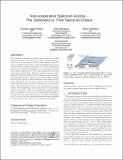Non-Cooperative Spectrum Access -- The Dedicated vs. Free Spectrum Choice
Author(s)
Jagannathan, Krishna Prasanna; Menache, Ishai; Zussman, Gil; Modiano, Eytan H.
DownloadModiano_Non-cooperative spectrum.pdf (383.4Kb)
OPEN_ACCESS_POLICY
Open Access Policy
Creative Commons Attribution-Noncommercial-Share Alike
Terms of use
Metadata
Show full item recordAbstract
We consider a dynamic spectrum access system in which Secondary Users (SUs) choose to either acquire dedicated spectrum or to use spectrum-holes (white spaces) which belong to Primary Users (PUs). The trade-off incorporated in this decision is between immediate yet costly transmission and free but delayed transmission (a consequence of both the possible appearance of PUs and sharing the spectrum holes with multiple SUs). We first consider a system with a single PU band, in which the SU decisions are fixed. Employing queueing-theoretic methods, we obtain explicit expressions for the expected delays associated with using the PU band. Based on that, we then consider self-interested SUs and study the interaction between them as a non-cooperative game. We prove the existence and uniqueness of a symmetric Nash equilibrium, and characterize the equilibrium behavior explicitly. Using our equilibrium results, we show how to maximize revenue from renting dedicated bands to SUs and briefly discuss the extension of our model to multiple PUs. Finally, since spectrum sensing can be resource-consuming, we characterize the gains provided by this capability.
Date issued
2012-12Department
Massachusetts Institute of Technology. Department of Aeronautics and Astronautics; Massachusetts Institute of Technology. Department of Electrical Engineering and Computer ScienceJournal
IEEE Journal on Selected Areas in Communications
Publisher
Institute of Electrical and Electronics Engineers (IEEE)
Citation
Jagannathan, Krishna, Ishai Menache, Eytan Modiano, and Gil Zussman. “Non-Cooperative Spectrum Access -- The Dedicated vs. Free Spectrum Choice.” IEEE Journal on Selected Areas in Communications 30, no. 11 (December 2012): 2251-2261.
Version: Author's final manuscript
ISSN
0733-8716